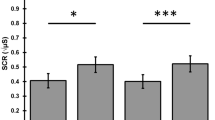Abstract
A polygraphic study on habituation of the somatic, autonomic, and EEG components of the orienting reaction elicited by a repetitive auditory stimulus during successive (weekly) sessions was performed in 29 patients with postmeningoencephalic epilepsy (PME) and in 116 control subjects. The study evidenced significant retention disturbances of orienting reaction habituation (i.e., of learning), the “saving” of stimulation, achieved from one session to another to obtain the habituation criterion, being lesser in PME patients than in control subjects. The severity of habituation retention disturbances depended on seizure frequency, electroclinical form, and history, as well as on features of EEG tracings.
Similar content being viewed by others
References
Chattopadhyay, P., Cooke, E., Toone, B., and Lader, M. Habituation of physiological responses in anxiety.Biological Psychiatry. 1980,15, 711–721.
Gastaut, H., Jus, C., Morrell, F.,et al. Étude topographique des réactions électroencéphalographiques conditionnées chez l’homme (Essai d’interprétation neurophysiologique).Electroencephalography and Clinical Neurophysiology, 1957,9, 1–34.
Gastaut, H., and Bert, J. Electroencephalographic detection of sleep induced by repetitive sensory stimuli. In G. Wolstenholme, M. O’Connor (Eds.), CIBA Foundation Symposium on the Nature of Sleep. Boston: Little Brown, 1961.
Jus, A., and Jus, C. Étude de l’extinction per répétition de l’expression EEG du réflexe d’orientation et de l’action du frein externe sur les réactions EEG aux différents stimuli chez l’homme.Electroencephalography and Clinical Neurophysiology, 1960, (Suppl.)13, 321–333.
Kimmel, H. D., and Goldstein, A. J. Retention of habituation of the GSR to visual and auditory stimulation.Journal of Experimental Psychology, 1967,73, 401–404.
Lader, M.The Psychophysiology of Mental Illness. London: Routledge & Kegan Paul, 1975.
Magoun, H. W.The Waking Brain. Springfield, Ill.: Charles C Thomas, 1958.
Penfield, W., and Erickson, T.Epilepsy and Cerebral Localisation. Springfield, Ill.: Charles C Thomas, 1941.
Penfield, W., and Jasper, H. H.Epilepsy and the Functional Anatomy of the Human Brain. Boston: Little Brown, 1954.
Raskin, M. Decreased skin conductance response habituation in chronically anxious patients.Biological Psychology, 1975,2, 309.
Roger, A., Voronin, L. G., and Sokolov, E. N. An electroencephalographic investigation of the temporary connexion during extinction of the orienting reflex in man.Pavlovian Journal of Higher Nervous Activity, 1958,8, 1–13.
Rogozea, R., and Florea-Ciocoiu, V. The orienting reflex in epilepsy. Electrographic data concerning the intraparoxysmal peculiarities of the orienting reflex in epileptics.European Neurology, 1973,9, 275–286.
Rogozea, R., and Florea-Ciocoiu, V. Nervous reactivity disturbances in patients with late post-traumatic encephalic syndromes.Applied Neurophysiology, 1979,42, 224–233.
Saarma, J. Autonomic component of the orienting reflex in schizophrenia.Biological Psychiatry, 1974,9, 55–62.
Siddle, D. A., Nicol, A. R., and Foggitt, R. H. Habituation and overextinction of the GSR component of the orienting response in antisocial adolescents.British Journal of the Society of Clinical Psychology, 1973,12, 303–321.
Sokolov, E. N. Orienting reflex, its structure and mechanism. In:Orienting Reflex and Orienting Explorative Activity. Moscow: University Press, 1958.
Sokolov, E. N. Neuronal models and the orienting reflex. InThe Central Nervous System and Behavior. New York: Josiah Macy Jr. Foundation, 1959, pp. 187–276.
Sokolov, E. N. Higher nervous functions: The orienting reflex.Annual Review of Physiology, 1963a,25, 545–580.
Sokolov, E. N.Perception and the Conditioned Reflex. New York: Macmillan, 1963b.
Tower, D. B., and Elliott, K. A. C. Activity of acetylcholine system in human epileptogenic focus.Journal of Applied Physiology, 1952,4, 669–676.
Tower, D. B.Neurochemistry of Epilepsy. Springfield, Ill.: Charles C Thomas, 1960.
Venables, P. H. The effect of auditory and visual stimulation on the skin potential response of schizophrenics.Brain, 1960,83, 77–84.
Author information
Authors and Affiliations
Rights and permissions
About this article
Cite this article
Rogozea, R., Florea-Ciocoiu, V. Retention of orienting reaction habituation in patients with postmeningoencephalitic epilepsy. Pav. J. Biol. Sci. 17, 9–15 (1982). https://doi.org/10.1007/BF03003471
Issue Date:
DOI: https://doi.org/10.1007/BF03003471



